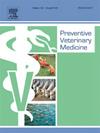Economic impact of productivity losses attributable to porcine reproductive and respiratory syndrome virus in United States pork production, 2016–2020
IF 2.4
2区 农林科学
Q1 VETERINARY SCIENCES
引用次数: 0
Abstract
The porcine reproductive and respiratory syndrome virus (PRRSV) continues to pose a major economic burden on the swine industry in the United States (US). This study estimates the annual cost of PRRSV-related productivity losses using US data from 2016 to 2020. Productivity data were collected from commercial swine herds with known PRRSV, porcine epidemic diarrhea virus (PEDV), and Mycoplasma hyopneumoniae statuses. The cost of PRRSV was estimated separately for breeding and growing herds. Data from 12 swine companies were used to estimate the cost of PRRSV in the breeding herds; PRRSV statuses were assigned to the breeding herd weeks based on the American Association of Swine Veterinarians (AASV) herd classification and outbreak history as follows: Breeding Herd (BH)-A if PRRSV-negative or provisionally negative, BH-B if PRRSV-positive stable, BH-C if PRRSV-positive unstable after 16-weeks post-outbreak, BH-D if within 16 weeks post-outbreak in PRRSV-affected herds, and BH-E if within 16 weeks post-outbreak in PRRSV-unaffected herds. Data from nine swine companies were used to estimate the cost of PRRSV in the growing herds, and statuses were assigned to growing groups as follows: Growing Herd (GH)-A if PRRSV-negative from weaning to market, GH-B if they were PRRSV-negative at weaning but became PRRSV-positive by market, and GH-C if they were weaned PRRSV-positive. Data on the distribution of US breeding herds by PRRSV status were sourced from the Morrison Swine Health Monitoring Program (MSHMP) database. Swine production-associated prices and costs were sourced from the USDA and InterPIG. An enterprise budgeting model was used to estimate the economic losses from reduced productivity caused by PRRSV. PRRSV caused annual losses of 380.82 million USD in the breeding phase and 819.41 million USD in the growing phase, 1.2 billion USD in total which is a significant increase from the 663.91 million USD reported in 2013. The updated estimates highlight the continuous and growing burden of PRRSV on US swine production.
2016-2020年美国猪肉生产中猪繁殖与呼吸综合征病毒导致的生产力损失的经济影响
猪繁殖与呼吸综合征病毒(PRRSV)继续对美国养猪业造成重大经济负担。本研究利用美国2016年至2020年的数据估算了prrsv相关生产力损失的年度成本。收集了已知PRRSV、猪流行性腹泻病毒(PEDV)和肺炎支原体状态的商品猪群的生产力数据。PRRSV的成本分别对繁殖和生长的畜群进行了估计。利用来自12家养猪公司的数据来估计种猪群中PRRSV的成本;根据美国猪兽医协会(AASV)的猪群分类和爆发历史,将PRRSV状态划分为种猪周:繁殖群(BH)为PRRSV阴性或暂时阴性,BH- b为PRRSV阳性稳定,BH- c为爆发后16周后PRRSV阳性不稳定,BH- d为爆发后16周内感染PRRSV的猪群,BH- e为爆发后16周内未感染PRRSV的猪群。使用来自9家猪公司的数据来估计生长猪群中PRRSV的成本,并将生长组的状态分配如下:从断奶到市场上PRRSV为阴性的生长猪群(GH)-A,断奶时PRRSV为阴性但市场上PRRSV呈阳性的生长猪群(GH)- b,断奶后PRRSV呈阳性的生长猪群(GH - c)。按PRRSV状态划分的美国种猪群分布数据来源于莫里森猪健康监测计划(MSHMP)数据库。生猪生产相关价格和成本来源于美国农业部和InterPIG。利用企业预算模型对PRRSV造成的生产力下降造成的经济损失进行了估算。PRRSV在繁殖阶段造成的年损失为38082万美元,在生长阶段造成的年损失为81941万美元,总计12亿美元,较2013年报告的6.6391亿美元有显著增加。最新的估计强调了PRRSV对美国养猪生产的持续和不断增长的负担。
本文章由计算机程序翻译,如有差异,请以英文原文为准。
求助全文
约1分钟内获得全文
求助全文
来源期刊

Preventive veterinary medicine
农林科学-兽医学
CiteScore
5.60
自引率
7.70%
发文量
184
审稿时长
3 months
期刊介绍:
Preventive Veterinary Medicine is one of the leading international resources for scientific reports on animal health programs and preventive veterinary medicine. The journal follows the guidelines for standardizing and strengthening the reporting of biomedical research which are available from the CONSORT, MOOSE, PRISMA, REFLECT, STARD, and STROBE statements. The journal focuses on:
Epidemiology of health events relevant to domestic and wild animals;
Economic impacts of epidemic and endemic animal and zoonotic diseases;
Latest methods and approaches in veterinary epidemiology;
Disease and infection control or eradication measures;
The "One Health" concept and the relationships between veterinary medicine, human health, animal-production systems, and the environment;
Development of new techniques in surveillance systems and diagnosis;
Evaluation and control of diseases in animal populations.
 求助内容:
求助内容: 应助结果提醒方式:
应助结果提醒方式:


